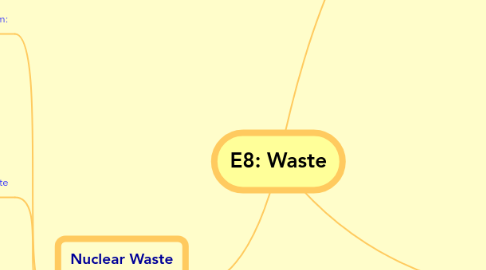
1. Nuclear Waste
1.1. From:
1.1.1. Hospitals;
1.1.2. Labs;
1.1.3. Power stations.
1.2. Low level waste
1.2.1. Protective clothing (such as gloves), paper etc that has come into contact with waste.
1.2.2. Usually short half-life
1.2.3. Can be kept in steel and concrete containers until radioactivity is at negligible levels.
1.2.4. Or, can be stored in cooled water (due to heat given off) as it decreases in radioactivity, then filtered through an Ion Exchange Resin, then discharged into the sea.
1.3. High Level Waste
1.3.1. Usually from spent fuel rods.
1.3.2. Fuel rods can be reprocessed, to regain much of the radioactive material, which is then used to create more power.
1.3.2.1. About 3%, though, is high level liquid waste.
1.3.2.1.1. This is dried in a furnace, then mixed with glass.
1.3.2.1.2. This is solidified in steel tubes that air is allowed to flow around to keep tmperatures cool.
1.3.2.1.3. The problem comes with storage of the solidified waste, as leaking of radioactivity could cause severe damage to water systems, the environment, and people.
1.3.3. Radioactivity is likely to last for thousands of years.
2. Methods of Disposal
2.1. Landfills
2.1.1. Convenient and cheap
2.1.2. Causes pollution:
2.1.2.1. Air;
2.1.2.2. Ground;
2.1.2.3. And water.
2.2. Ocean Dumping
2.2.1. Source of nutrients
2.2.2. Cheap and convenient
2.2.3. Danger to marine life
2.3. Open Dumping
2.3.1. Convenient and cheap
2.3.2. Causes pollution:
2.3.2.1. Air:
2.3.2.2. Ground:
2.3.2.3. And water.
2.4. Incineration
2.4.1. Reduces volume
2.4.2. Provides odourless, stable waste
2.4.3. Products can be used
2.4.4. Can be used to provide power
2.4.5. Expensive to build and operate
2.4.6. Requires energy to burn
2.4.7. Could produce dioxins if not burnt properly.
2.4.8. Produces greenhouse gases.
3. Recycling
3.1. Provides sustainability
3.2. Expensive
3.3. Difficulties in separation of materials
3.4. Metals
3.4.1. Aluminium
3.4.1.1. Requires a lot of energy to make from bauxite (raw aluminium extracted from ground)
3.4.2. Steel
3.4.2.1. Can be collected and melted
3.5. Paper
3.5.1. Sorted into grades
3.5.2. Made into low quality paper materials such as newspaper and toilet rolls.
3.5.3. Can be added to new paper derived from wood pulp to make partially recycled paper - can be just as high quality as entirely wood pulp derived paper.
3.5.4. Can be composted.
3.6. Glass
3.6.1. Sorted by colour, then melted.
3.7. Plastics
3.7.1. Broken down by:
3.7.1.1. Pyrolysis;
3.7.1.2. Hydrogenation;
3.7.1.3. Gasification;
3.7.1.4. Thermal cracking;
3.7.1.5. And then repolymerised
3.7.2. Can be difficult to separate plastics.
